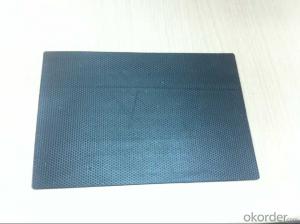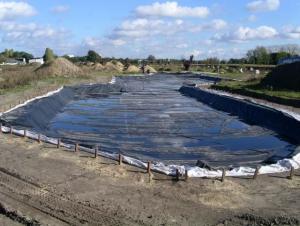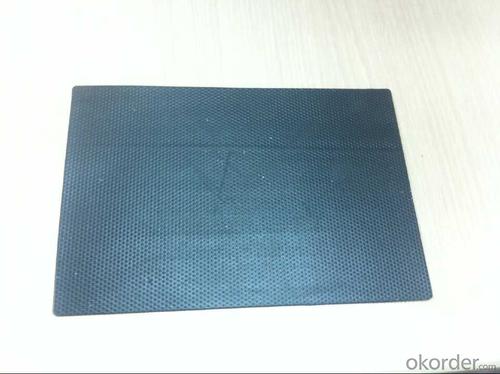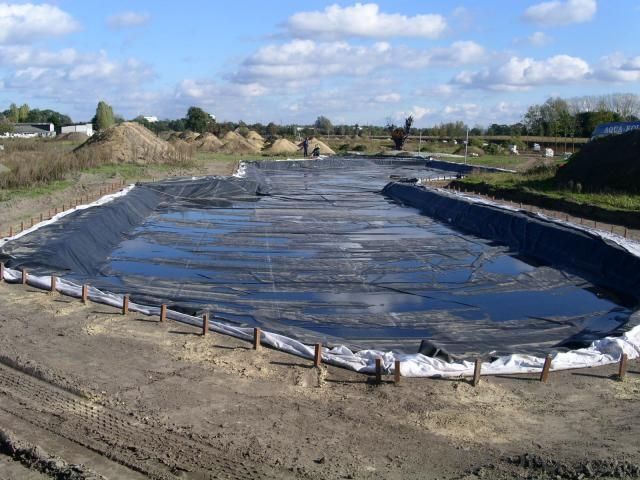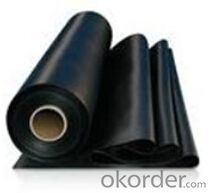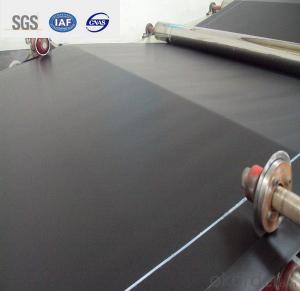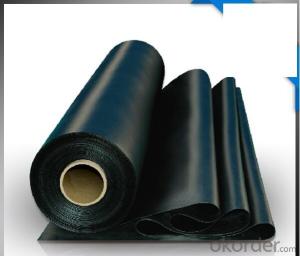EPDM roof /pond waterproof membrane with SGS ISO
- Loading Port:
- Qingdao
- Payment Terms:
- TT or LC
- Min Order Qty:
- 1000 m²
- Supply Capability:
- 100000 m²/month
OKorder Service Pledge
OKorder Financial Service
You Might Also Like
EPDM Coiled Rubber Waterproof Membrane for Ponds
1. Brief Introduction:
It is a kind of self-adhesive waterproof coiled material based on polymer rubber and superior asphalt, together with polyethylene film and aluminum foil as surface material or no film(Double-sided self-adhesive). And it adopts the package preventing-adhesion-isolation-layer package, and dividing into no fiber and polyester fiber two parts.The coiled material has perfect performances, simple operation, non-pollution and etc.
2. Characters:
1)Good flexibility, creep properties and malleability, and the superior adapting ability to the deformation of the primary stress generated.
2). Tight adhesion between waterproof layer and basic layer, no channeling water. Having self healing ability after piercing.
3).Operation without heating. And possessing the reliability of pasting by itself with super strong connection of sheet materialand adhesion of same base.
4). Convenient and safe operation, no pollution to the environment.
3.Specifications of EPDM Rubber Waterproof Membrane:
Material | EPDM Rubber |
Size | 1.2m (width)*20m (length) or customized, weldable type 2.05m or 4m width |
Thick | 1.2mm, 1.5mm, 2.0mm |
Type | Vulcanized & Weldable |
Pattern | Non-reinforced (homogeneous) |
Certificate | ISO9001/14001 |
4. IMages of EPDM Rubber Waterproof Membrane:

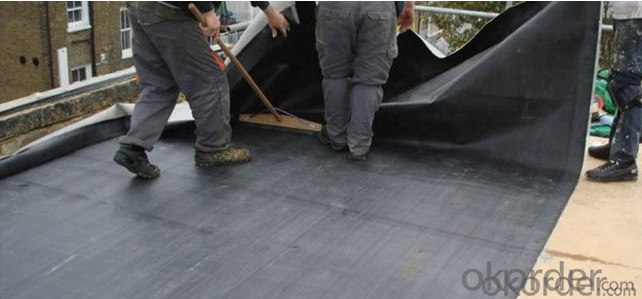
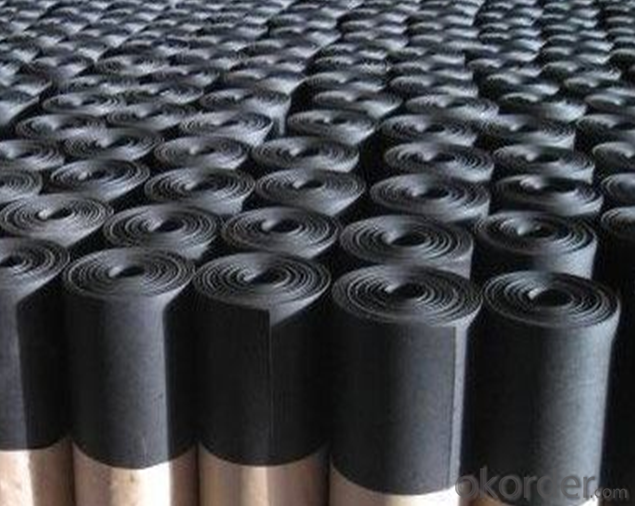
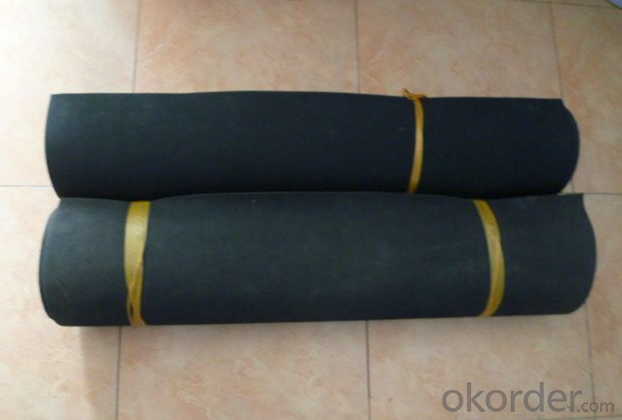
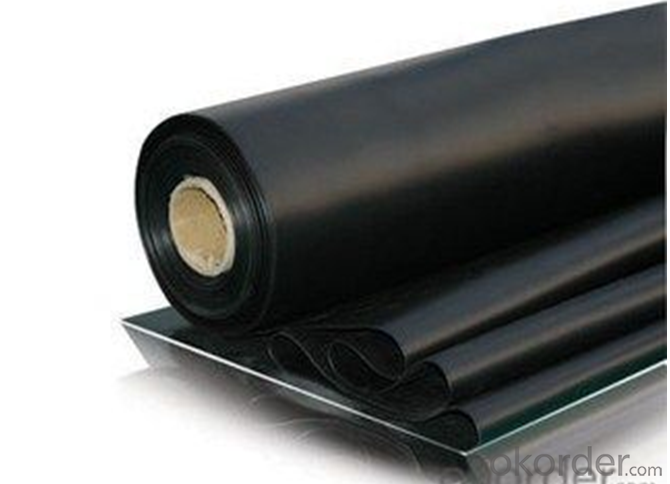

FAQ:
1. What are we supplying?
We are specialized in producing Colorful Asphalt Roof Shingle, SBS/APP modified bitumen waterproof membrane, Self adhesive bitumen waterproof membrane, PVC waterproofing membrane, EPDM rubber roofing membrane, Single Component Polyurethane Waterproof Coating, and Spray Polyurea Waterproof Coating
.
2. How Many years experience do we have?
We have been exported to more than 20 countries in the past 15 years.
3. How long do we usually reply your request?
We always reply our customer within 24 hours.
- Q: Can a waterproofing membrane be used in swimming pools or other water features?
- Yes, a waterproofing membrane can be used in swimming pools or other water features to prevent water leakage and maintain a watertight environment.
- Q: Does a waterproofing membrane prevent water damage to building materials?
- A waterproofing membrane is specifically designed to shield building materials from water damage. Its purpose is to act as a barrier, preventing water from infiltrating the structure and causing harm. Typically, the membrane is applied to areas prone to water intrusion, such as roofs, basements, and foundations. By creating a watertight seal, it effectively stops water from seeping through and harming the building materials. This safeguard is essential in maintaining the structure's integrity and preventing issues like mold growth, rot, and material decay. However, it's crucial to acknowledge that the effectiveness of a waterproofing membrane can vary based on the product's quality and proper installation. Regular maintenance and inspections are also necessary to ensure the membrane remains intact and continues to safeguard against water damage.
- Q: Can waterproofing membranes be used on utility manholes?
- Utility manholes can indeed benefit from the use of waterproofing membranes. These specialized membranes are specifically engineered to create a barrier against water infiltration, making them perfectly suited for areas where water is present, such as manholes. To prevent any potential damage to the structure or the utilities within, these membranes are typically applied to the walls and floors of the manhole, effectively preventing water from seeping through. This process not only maintains the integrity and functionality of the utilities, but also helps to avoid water-related issues like corrosion, leaks, and material degradation. Furthermore, waterproofing membranes offer additional protection against elements such as chemicals, gases, and soil contaminants that may be found in or around the manhole. Thus, the application of waterproofing membranes on utility manholes is a widely adopted practice to guarantee their long-term durability and functionality.
- Q: What are the advantages of using a waterproofing membrane?
- Using a waterproofing membrane offers numerous benefits. Firstly, it creates a protective barrier that prevents water from penetrating the structure. This is particularly crucial in areas prone to heavy rainfall or water exposure, like basements, roofs, or balconies. By safeguarding against water seepage, it preserves the building's integrity and prevents water-related issues such as leaks, mold growth, and structural deterioration. Secondly, a waterproofing membrane prolongs the lifespan of the structure. By defending against moisture intrusion, it hinders the corrosion of building materials such as concrete, metal, or wood. Consequently, this significantly extends the structure's longevity and reduces long-term maintenance and repair expenses. Furthermore, the use of a waterproofing membrane enhances the energy efficiency of a building. By preventing water infiltration, it also prevents air leakage, resulting in better insulation. This reduces energy loss and enhances the building's overall energy performance, leading to lower heating and cooling costs. Moreover, a waterproofing membrane improves the indoor air quality of a building. By blocking water entry, it prevents the growth of mold, mildew, and other harmful microorganisms. This is particularly advantageous for individuals with respiratory issues or allergies, as it ensures a healthier living environment. Finally, a waterproofing membrane increases the value of a property. Prospective buyers or tenants are drawn to buildings that are well-protected against water damage, providing them with peace of mind and reducing the risk of future issues. Therefore, investing in a waterproofing membrane is a wise decision for property owners, as it enhances the marketability and value of their assets. In conclusion, the advantages of using a waterproofing membrane include protection against water damage, increased structure lifespan, improved energy efficiency, enhanced indoor air quality, and increased property value.
- Q: Can a waterproofing membrane be used on asphalt roofs?
- Yes, a waterproofing membrane can be used on asphalt roofs. In fact, it is a common practice to apply a waterproofing membrane on asphalt roofs to enhance their durability and protect them from water damage. The membrane is typically made of a synthetic material, such as modified bitumen or EPDM, which creates a barrier against water infiltration. This helps prevent leaks and extends the lifespan of the asphalt roof. Additionally, the waterproofing membrane can also provide added insulation and energy efficiency benefits to the building. However, it is important to ensure that the specific waterproofing membrane chosen is compatible with asphalt and meets the necessary industry standards for performance and durability. Consulting with a professional roofing contractor or manufacturer is recommended to determine the most suitable waterproofing membrane for asphalt roofs.
- Q: Can a waterproofing membrane be used on steel surfaces?
- Yes, a waterproofing membrane can be used on steel surfaces. Waterproofing membranes are designed to create a barrier against moisture and water infiltration, and they can be applied to various surfaces, including steel. Steel surfaces are commonly found in construction projects, such as roofs, balconies, and foundations. Applying a waterproofing membrane on steel surfaces helps to prevent corrosion and damage caused by water exposure. It is important to select a waterproofing membrane that is suitable for steel surfaces and ensure proper surface preparation and application techniques for optimal performance and durability.
- Q: Can a waterproofing membrane be painted or coated?
- Yes, a waterproofing membrane can be painted or coated. However, it is essential to use a paint or coating specifically designed for use on waterproofing membranes. These types of paints or coatings are typically elastomeric, meaning they can stretch and move with the membrane without cracking or peeling. Additionally, the paint or coating should be compatible with the waterproofing membrane material to ensure proper adhesion and longevity. Before applying any paint or coating, it is advisable to clean and prepare the surface according to the manufacturer's instructions. It is also crucial to follow the recommended application process and allow sufficient drying and curing time for the paint or coating. Overall, painting or coating a waterproofing membrane can enhance its appearance, provide additional protection against UV rays and environmental elements, and extend its lifespan.
- Q: Can a waterproofing membrane be used for interior applications?
- Yes, a waterproofing membrane can be used for interior applications. Waterproofing membranes are typically used to prevent water penetration and protect structures from moisture damage. While they are commonly used for exterior applications such as roofs, foundations, and basements, they can also be used for interior applications. In interior spaces, waterproofing membranes can be installed in areas prone to moisture, such as bathrooms, showers, laundry rooms, and kitchens. These membranes help to create a barrier against water, preventing it from seeping into the walls, floors, or other structural components. By using a waterproofing membrane for interior applications, you can protect your property from water damage, mold, and other potential issues caused by moisture.
- Q: Can waterproofing membranes be used on metal roofs?
- Yes, waterproofing membranes can be used on metal roofs. These membranes are designed to create a protective barrier against water infiltration, and they can be applied to various roofing materials, including metal. Waterproofing membranes provide an effective solution to prevent leaks and extend the lifespan of metal roofs.
- Q: Can a waterproofing membrane improve energy efficiency?
- Yes, a waterproofing membrane can improve energy efficiency. A waterproofing membrane acts as a barrier against moisture intrusion, preventing water from seeping into the building envelope. By keeping the structure dry, it helps to prevent the growth of mold and mildew, which can contribute to poor indoor air quality and the deterioration of building materials. In addition to protecting against moisture, a waterproofing membrane can also provide insulation benefits. Many waterproofing membranes are designed to have a high thermal resistance, or R-value. This means that they can provide an extra layer of insulation to the building, reducing heat transfer through the walls or roof. By improving the building's thermal performance, a waterproofing membrane can help to reduce the load on heating and cooling systems, resulting in energy savings and improved energy efficiency. Furthermore, a waterproofing membrane can also help to reduce air leakage in a building. Air leakage can account for a significant amount of energy loss, as conditioned air escapes through gaps and cracks in the building envelope. By sealing off these areas, a waterproofing membrane can help to improve the building's air tightness, reducing energy loss and improving energy efficiency. Overall, a waterproofing membrane can play a crucial role in improving energy efficiency by preventing moisture intrusion, providing additional insulation, and reducing air leakage. Investing in a high-quality waterproofing system can lead to long-term energy savings, improved indoor comfort, and a more sustainable and efficient building.
Send your message to us
EPDM roof /pond waterproof membrane with SGS ISO
- Loading Port:
- Qingdao
- Payment Terms:
- TT or LC
- Min Order Qty:
- 1000 m²
- Supply Capability:
- 100000 m²/month
OKorder Service Pledge
OKorder Financial Service
Similar products
Hot products
Hot Searches
Related keywords
